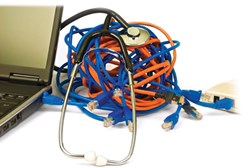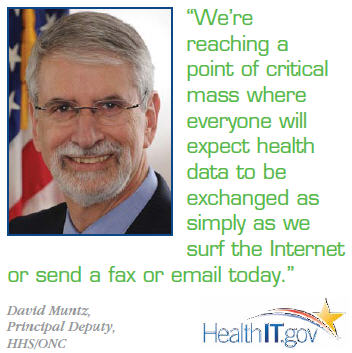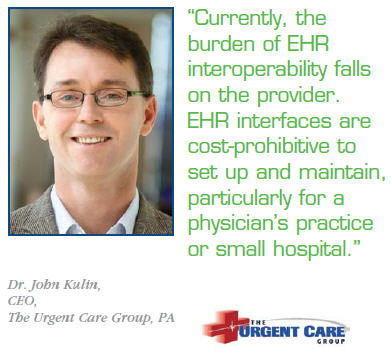Fixing The EHR Interoperability Mess

By Ken Congdon
EHR adoption is on the rise, but interoperability remains a key roadblock. What needs to happen to facilitate an environment of open-data exchange?
 According to the latest figures by HHS, EHR adoption is going strong in the U.S. — with more than 80 percent of eligible hospitals and 50 percent of doctors slated to leverage EHR systems by the end of 2013. It seems as though we’ve reached the tipping point in EHR adoption. This is great news, but it’s only the first step in a much grander plan. The fact is, EHR adoption will do little good if the systems don’t ultimately share patient data with one another. Dr. Farzad Mostashari and other leaders of the ONC have been forced to repeatedly defend the nation’s progress in regards to EHR interoperability before Congress. One of the central issues is the siloed and proprietary nature in which most EHR products on the market are designed today. These systems aren’t built to easily and openly share data with competitive products.
According to the latest figures by HHS, EHR adoption is going strong in the U.S. — with more than 80 percent of eligible hospitals and 50 percent of doctors slated to leverage EHR systems by the end of 2013. It seems as though we’ve reached the tipping point in EHR adoption. This is great news, but it’s only the first step in a much grander plan. The fact is, EHR adoption will do little good if the systems don’t ultimately share patient data with one another. Dr. Farzad Mostashari and other leaders of the ONC have been forced to repeatedly defend the nation’s progress in regards to EHR interoperability before Congress. One of the central issues is the siloed and proprietary nature in which most EHR products on the market are designed today. These systems aren’t built to easily and openly share data with competitive products.
According to David Muntz, principal deputy at HHS/ ONC, this siloed approach by vendors was not unexpected. “EHR vendors, with no ill intent, but simply because they wanted to get things done rapidly, created interfaces that work within their existing software and the equipment they were familiar with,” he says. “They didn’t take time to design an interface that is going to work with every other product. That’s natural. Just like auto parts are not interchangeable between models, EHR vendors went about building the best self-contained EHR solution they could.”
EHR Incompatibility Stymies Clinical Effectiveness
While it may not be ill-intended, the proprietary nature of today’s EHR products creates several challenges for today’s healthcare providers. For example, Dr. Allen Gee, a neurologist and owner of his own practice, Frontier Neurosciences, has been an EHR user since 2006. He’s happy with the data and clinical workflow benefits his use of the athenahealth platform bring to his practice internally, but his productivity and patient visibility are often stymied when trying to work with other providers that use different EHR systems.
“As a specialist, I’m referred patients from PCPs and I also have to work with the hospitals in my region,” he says. “These facilities use a variety of different EHRs including Meditech, Cerner, and NextGen. There is significant dysfunction when it comes to sharing electronic information between these systems. Currently, when we need to access a patient record from another provider, we ask them to send us a fax of the record from their EHR. We receive an analog form, which we attach to our electronic record. However, our staff must manually extract the pertinent data from the form and enter it into the discrete data fields in athenahealth. This is an extra step that is time-consuming and can introduce human error into the process.”

Similarly, Dr. John Kulin, CEO of The Urgent Care Group, PA, an urgent care center in Manahawkin, NJ, says the lack of EHR interoperability makes it challenging for his staff to track down the medical histories of the patients they see episodically. “I know interoperability is possible because we currently have an excellent exchange between our EHR and the different pharmacy systems in our area. We never have a problem identifying the medications our patients are taking. However, we hit a snag when it comes to accessing patient histories from other providers, and we often need these before we can properly treat a patient. More often than not, we’re getting a printout of an EHR entry or a copy of a paper chart, scanning it, and attaching the file to the patient record in our EHR. This process is not expedient, which adds to the length of the patient visit.”
Cost And Sustainability Concerns Stall HIE, Interface Investments
While several challenges still need to be overcome with regards to EHR interoperability, it’s not like strides haven’t been made toward this end. For example, several standards, such as direct protocol (a standards-based method for allowing participants to send authenticated and secure messages via the National Health Information Network), as well as those developed by HL7 (Health Level Seven), a nonprofit global health IT standards organization, provide EHR users with the building blocks for exchanging data. Blue Button, an application developed by the VA that allows patients to download their own health records, is also being adopted and manipulated by EHR vendors and independent developers as a way for providers to exchange data between systems. Moreover, regional and state-run HIEs offer healthcare providers in several parts of the country a network they can join (and technology infrastructure they can leverage) to share health data with other HIE members.
While these interoperability tools currently exist, they haven’t been adopted as widely as EHRs. According to Muntz, there’s a simple explanation for this.
“We’ve developed (and continue to develop) standards and governance with the input of the healthcare community — providers, payers, and vendors,” he says. “This was done intentionally to ensure the standards are useful and work for a variety of technologies. Getting everyone to agree upon standards and the rules of the road is not easy. It takes time. There are a lot of prerequisites that need to occur before we realize universal interoperability, but I feel we have a solid foundation in place. The first step is to get all providers using EHRs.”
Providers, however, have a different perspective on why EHR interoperability has been slow on the uptake. To them, it all comes down to dollars and cents.
“Currently, the burden of EHR interoperability falls on the provider,” says Dr. Kulin. “EHR interfaces are costprohibitive to set up and maintain, particularly for a physician’s practice or small hospital. You’re asking providers to outlay a ton of money to achieve interoperability with no clear financial incentive for them to do so.”
According to Dr. Gee, money also plays a big role in determining the ultimate usefulness of Wyoming’s HIE. “I think our state HIE has the functionality necessary to enable health data exchange. However, the platform costs a few million dollars to develop, and costs more than a million dollars a year to maintain. It’s currently being sustained by government grant money, but when this runs out, it’s in trouble. The provider buy-in to the HIE is shamefully low. We only have 843 providers and 25 hospitals total in the state of Wyoming. Even if all of them participated, you’d have trouble generating the $1 million necessary to maintain the HIE year after year. With the miniscule participation we have now, there’s no possibility of sustainability after the grants dry up.”
Stage 2 MU And Reform Provides Strong Interoperability Motivation
While progress in the area of EHR interoperability has been slow to date (for several reasons), Muntz cites several developments that will likely spur data exchange between systems going forward. One such driver will be Stage 2 Meaningful Use (MU).
“The ONC made interoperability a fairly low barrier for EHR vendor certification under Stage 1 MU,” he says. “A vendor just had to be able to demonstrate its software could do it, and it didn’t have to be with a completely different kind of EHR system. The requirements for Stage 2 certification require vendors to be able to exchange data with an EHR from another vendor. This will require a lot more standardization, and should facilitate a much broader exchange.”
The provider reimbursement changes that are taking shape under healthcare reform will also likely motivate EHR interoperability, according to Muntz. For example, for ACOs to succeed, data will need to flow between providers within each ACO fluidly and securely. Sharing electronic data in real time will help ensure that data is accurate and received in a timely manner, which should help providers deliver a higher level of care, improve outcomes, and maximize their reimbursement under the pay-for-performance model.
Healthcare providers, however, expect more than this from their EHRs going forward. “To me, EHR interoperability begins at the point of care,” says Dr. Gee. “A great deal of dysfunction exists when it comes to getting physicians to use EHRs correctly when interacting with patients. If data is poorly entered into the EHR to begin with, then what good does it do to exchange this flawed information with other systems? Doctors shouldn’t be forced to do data entry or abstraction. They should be the ones verifying the data. EHR technology should facilitate doctor/patient interactions. To do so, more intelligence needs to be built into these systems to allow data already contained in electronic documents to be automatically extracted and uploaded into discrete EHR data fields that physicians can manage, manipulate, and cross-reference. This will transform EHRs from electronic file cabinets to truly valuable assets for clinicians.”
EHR Interoperability Requires A Unified Effort & Open Data
One area where Muntz, Dr. Gee, and Dr. Kulin all agree is that realizing true EHR interoperability will take the collective effort of several healthcare stakeholders — namely, the government, providers, payers, and patients. However, each has a different viewpoint on what roles these stakeholders should play in this transformation. Muntz believes the government’s role is to be responsive when the market fails to do what’s best for providers and patients. He also believes providers need to leverage the highest quality technology to engage and care for patients. Dr. Kulin, on the other hand, believes true interoperability won’t be realized unless payers (Medicare and major insurers) force the issue. Finally, Dr. Gee believes private industry needs to be appropriately incentivized to solve the EHR interoperability problem.
However we get there, all three agree that EHR interoperability needs to be much more seamless than it is today. In other words, health data should be able to be transmitted from a point of origin to a designated endpoint with minimal human effort.

“I believe we’ll get to this point over the next few years,” says Muntz. “We’re reaching a point of critical mass where everyone will expect health data to be exchanged as simply as we surf the Internet or send a fax or email today. Once this occurs, the possibilities are endless. This exchange will present new opportunities for innovation that didn’t exist before. For example, providers will be able to apply analytics tools to this collective data to identify patterns we didn’t know existed and act upon them. The possibilities in terms of discovery are very exciting.”
The EHR interoperability utopia Muntz describes definitely is appealing. However, I feel we’re a bit farther away from this target than Muntz does. To me, the siloed design of many of today’s EHRs will be a difficult hurdle to leap, and it’s one I’m not convinced the industry is approaching the right way. For example, we’re currently trying to get EHRs with proprietary formats to share data through interfaces and exchanges that take the data from one system’s language and basically translate it to the language of the receiving system. As with any data exchange that occurs in this fashion, some information can be lost in translation. This can be potentially devastating when dealing with a patient record. In my opinion, true exchange requires truly open data. Why can’t EHR vendors simply compete based on the features and usability of their platforms instead of the proprietary formats in which they collect and format data?
We have seen some progress in regards to EHR vendors working together to achieve interoperability. For example, in March 2013, the CommonWell Health Alliance was announced. This alliance is made up of several leading EHR vendors (e.g. Cerner, McKesson, athenahealth, Greenway, and Allscripts) and intends to create an open, vendor-neutral platform for interoperability between member systems. This initiative is definitely a step in the right direction, but it’s more of a “walled garden” than a truly open-data protocol for interoperability. Hopefully, however, CommonWell will get more vendors to think about the necessity of sharing health data, and will help create the “critical mass” effect that Muntz refers to.
